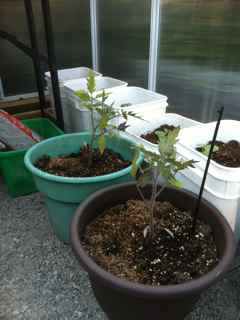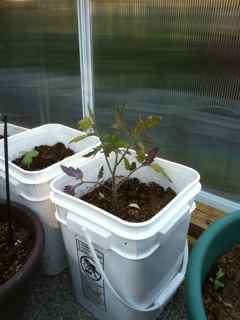| Back to Back Issues Page |
 |
|
Vegetable Gardening Hints, Issue #047 May 17, 2012 |
Hello, Now's the time to start planting.The middle of May in most northern climates is the time to get your transplants and seeds into the garden. The soil is usually warm enough by the end of May to plant all the heat loving plants such as tomatoes, peppers, beans, and squash. If you already have veggies growing now is also a great time to put some more seeds such as lettuce, chard, and root crops into the ground so you can be eating into the fall. Here are some tips for planting a
variety of veggies.
My garden it growing great. We have been eating lettuce, spinach, arugula, cilantro and kale for the past few weeks. We have peas and potatoes coming up, our carrots and beets are still quite small but growing. This coming week we will be putting out our squash and cucumber transplants, broccoli transplants (a little late but we will enjoy them in August), and will be planting our beans.
Since we have put up a new greenhouse we have decided to plant our tomatoes in pots in our greenhouse this year. 

We have a guest post from Erik Braunitzer Tomatoes: Organic Gardening 101 With a showcase of luxurious Hamptons Homes, Douglas Elliman serves both the NYC & Long Island areas. Feel free to connect with the author via twitter @ellimanbraun. Spring is on the way, so hopefully, you have already started preparing your garden soil and getting it ready for planting. By now, you should have already worked all the decaying leaves from your trees this past fall, into your soil. If that option is not available to you, you can buy store bought potting soil or compost to add to the native soil. When looking for organic fertilizers, make sure the product is labeled natural organic or slow release. Another tip is to make sure the NPK (nitrogen, phosphorus, potassium) ratio never adds up to more than 15. Preparation of the planting hole is crucial. No matter what the size of the plant, dig a hole that would basically hold a two-gallon plant. You want your newly planted seedling to be able to grow and throw out a good root system with nothing to impede its growth. Backfill your planting hole with a good mix of potting soil or compost with some of the native soil until you have a nice soil that will retain moisture well, but will also be a well-drained soil. Add a small amount of fertilizer, according to package directions for your size of plant. You want to make sure you do not burn the young tender root system. When you have finished backfilling your hole, reach down and scoop up a handful of soil and squeeze it. If is holds together nicely without becoming a hard clump or falling apart in your hand, you have the perfect mix now for planting those beautiful little tomato plants. When planting the tomatoes, make sure you plant the bush deep enough so it does not topple from the weight of your bountiful harvest. Either use tomato cages or trellis your plants for support. Just check and tie up new growth every few days, as needed. Throughout the growing season, remember to side-dress your tomato plants every few weeks with more fertilizer as the plants use up the available supply. A good rule of thumb is if the plants start to look a little light green, it is time to side-dress. Just work a little fertilizer into the top inch of the soil. There are many organic homemade pest control recipes on the Internet. Just remember to add dish soap and vegetable oil to your mix so that it adheres to the plants. Be sure and plant marigolds around your garden since they repel many of the insects that attack your plants too. Do not forget there are many beneficial insects such as ladybugs, spiders and some beetles that feast on aphids and cutworms. Even with all your due diligence and hard work, Mother Nature plays a crucial role in the success of your garden. If we have an unusually late start to summer, if it turns out to be cool all year or if summer turns out to be the scorcher of the century, there is only so much you can do and hope for the best.
Alternative Garden I have decided to try a
straw bale garden
this spring. We planted some lettuce and parsley into the straw bale, however the straw started growing, not our transplants! The bale needs to decompose more so I have it wrapped in plastic and have wet it so hopefully this will help it to rot a bit more. Stay tuned next ezine.
Watering Proper watering is crucial when setting out transplants or planting seed. Make sure you water transplants at least once a day (if it is warm twice a day) when they are small as the roots are close to the surface and will dry out quickly. Gently water around the base of the plants so as not to damage the small leaves. Seeds need to be watered as well (with the exception of
beans
) as the seed needs to stay moist in order to sprout. Again watering once a day or twice if it is warm so the seed will stay moist. Once the seeds have sprouted you can gently overhead water. For more
watering tips
check out this info.
My new ebooks will help with your planning, check them out. Why is Soil so Important is a new ebook to help in planning to get your soil ready for next year's garden.
My 2012 Vegetable Garden Journal
is a full package planning/journal book. You get the dates that are best for planting above and below ground crops, tips on how to grow 25 common vegetables, as well as tonnes more info to create a successful garden.
2012 Vegetable Planting Calendar
gives you the best dates to plant your vegetable garden by the moon cycles. Learn more about
planting by the moon cycles
All will make for wonderful winter reading and will assist in planning for next season. These are perfect gifts for any gardeners on you Christmas list as well.
Please contact me with your comments and suggestions. If you have enjoyed this ezine please tell a friend.
Welcome to the world of vegetable gardening! Catherine |
| Back to Back Issues Page |